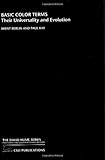But another puzzler I encountered as I learned Chinese, first in the United States and then in Taiwan, was the broad range of colors that would be identified as 黃 (traditionally translated "yellow," a term definitely used for the yolk of an egg). One day in Chinese class in Taipei, my teacher, an older (birth decade 1930s) native speaker of Mandarin who grew up in Beijing, referred to the wooden tabletop in our classroom as 黃 in color. Aha! The term 黃 covers the full range of not just yellow, as we refer to yellow in English, but also pretty much the entire range of what English speakers call brown. Of course. Now I understand why the "Yellow River" 黃河 is called that, even though when I have seen it directly the silt in the river made it look brown to my eyes, not yellow. And similarly for referring to grass browning ( 變黃 ) in autumn, as to my English ear, I would not call the color of grass in autumn "yellow" but rather brown.
The book Basic Color Terms: Their Universality and Evolution by Brent Berlin and Paul Kay
http://www.amazon.com/Basic-Color-Terms-Universality-Evoluti...
was originally published in 1969, and it set the agenda for subsequent studies of how color terms vary across languages. The conclusion (as also related in the blog post kindly submitted here) is that most languages around the world begin with a very basic set of color terms that gradually accumulates more fine distinctions, in a generally invariant order across most world cultures. English has many color terms, but not quite as many BASIC color terms as a few other European languages.
We can see this same kind of process in older terms and phrases in English. What is called "red hair" in English (my late dad had that hair color) would more likely be called "orange hair" today, except that there was no word "orange" in English (that comes from the name of a foreign fruit, after all) at that time, so the word "red" had the full semantic range of today's word "red" and today's word "orange." That's quite comparable to the situation in modern Chinese, where there now are competing, very new, words for "brown" ("[coconut] palm-colored" or "coffee-colored" often being used in actual daily conversation) but many historical phrases in which 黃 ("yellow") is used for colors in the same range.


https://www.amazon.com/Basic-Color-Terms-Universality-Evolut...
(Noting that different languages do have differing numbers of basic color terms.)